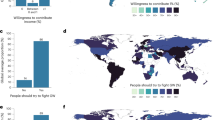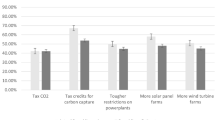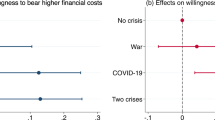Abstract
Increasingly, climate activists use nonviolent civil disobedience (NVCD) to raise awareness about the need to end fossil fuel use. In two small studies we explored the potential of NVCD to enhance U.S. public support for this goal. Study 1 showed that some NVCD actions (e.g., marches and sit-ins) and some targets of those actions (e.g., fossil fuel companies) are seen as more acceptable than other targets (e.g., ordinary people). Study 2 suggested that perceived acceptable NVCD actions against perceived acceptable targets may be more effective than other forms of NVCD. We provide some potential directions for future research to better elucidate understanding on this topic.
Similar content being viewed by others
In mid-October 2022, climate activists entered the National Gallery in London. They stopped by one of the gallery’s most frequently visited works of art, Vincent Van Gogh’s Sunflowers, opened a can of tomato soup, doused the painting (encased in a protective glass frame), and glued themselves to the wall. The protesters called for eliminating fossil fuels, like oil, to abate further climate change1,2,3. This act is just one example of an increasingly common trend of activists adopting NVCD to advocate for more ambitious efforts to address climate change. Engaging in NVCD has been used to attract attention to the impacts of climate change, with forms of protests such as sit-ins, blockades, and throwing soup or paint becoming more common tactics to gain attention and news coverage4.
These acts of NVCD have drawn widespread media attention, as well as criticism, for example by The International Council of Museums (ICOM)5. Many in the public have also reacted negatively to these tactics; a recent poll found that 46% of American adults feel that NVCD actions decrease their support for efforts to curb climate change6. Thus, an open question is: Do these types of protests help build a broad coalition of support necessary for systemic change7?
Here, we focus on the concept of perceived appropriateness, defined as the degree to which people see an action – and/or the target of that action – as being appropriate for NVCD. Perceived legitimacy is a relevant theory and is useful for conceptualizing how certain groups view the actions of others8. However, for this study, we have chosen to operationalize legitimacy as perceived appropriateness, as a general representation of whether one views a specific action as appropriate or not. Study 1 was guided by the research question:
Are there differences in perceptions of appropriateness for different NVCD actions and targets?
We surveyed 400 Americans (n = 380 after removing non-finishers/consenters and those that failed attention checks) via Prolific and age and sex were quota matched in-line with U.S. census parameters (race was partly matched, although not ethnicity, and hence, our sample is underrepresented with respect to Hispanic Americans). Participants were asked to rate a randomized list of 16 NVCD tactics and 16 targets—that were based on actual events—on a 7-point scale from highly inappropriate to highly appropriate. We found significant differences in the perceived appropriateness of both NVCD targets and actions (Fig. 1). The targets perceived to be most appropriate were fossil fuel companies (M = 5.77), CEOs of fossil fuel companies (M = 5.64), and federal government officials that promote fossil fuels (M = 5.61); least appropriate were museums that do not accept fossil fuel funding (M = 2.32), ordinary people (M = 2.88), and commuters driving to work (M = 3.39). The actions perceived as most appropriate were boycotts (M = 6.09), public marches/rallies (M = 5.76), and sit-ins (M = 5.27); least appropriate were physical assault (M = 1.45), soup throwing (M = 1.53), and breaking into buildings (M = 1.86). Many more targets (81%) than actions (31%) were seen as at least slightly appropriate.
Acceptability means for actions and targets—Means (teal=grand mean) for acceptability for targets a and actions b of civil disobedience with means for Republicans (red diamonds) and Democrats (blue diamonds). The horizontal lines for all three groups represent 95% confidence intervals. Acceptability was rated on a 7-point scale from highly inappropriate (1) to highly appropriate (7).
Democrats rated nearly all actions and targets as more appropriate than did Republicans, although, with few exceptions, the two group’s relative ratings were remarkably consistent (Fig. 1a, b). Both groups agree that certain forms of civil disobedience and certain targets are appropriate, and other forms inappropriate.
In summary, most Americans view climate-related NVCD as appropriate if it is non-violent and targeted towards those companies or entities which are responsible for taking actions to the detriment of the climate. This could be in the form of promoting fossil fuel use, or even accepting fossil fuel financing. Conversely, actions that are violent, or targeted at entities not seen as being responsible for exacerbating climate change are seen as inappropriate targets.
Next, harnessing the findings from Study 1, we tested whether presenting Americans (sampled in the same way as in the prior study) with perceived appropriate forms of NVCD would result in greater support for the climate movement than presenting perceived inappropriate forms. Using a 2 × 2 pre-post experimental design (n = 391), we hypothesized that people who read a statement describing a form of NVCD perceived to be entirely appropriate (i.e., both action and target) would show greater support for the climate movement (an index comprised of support for the movement, feelings towards activists, and willingness to participate, αpre = 0.83 & αpost = 0.85) than people who read a statement describing a partially appropriate form (action or target), or an entirely inappropriate form. A stimulus sampling approach was used where one of three potential messages was shown per experimental group (see supplementary materials for a graphical representation).
Before and after reading the scenario, participants answered a series of questions pertaining to support for the climate movement (which were subsequently averaged into an index) and acceptability of the action/target. As a test of the effectiveness of our experimental factors, a one-way ANOVA comparing three groups (high, medium, and low appropriateness) demonstrated a significant effect of condition on perceived appropriateness (F(2, 341) = 38.6, p < 0.001). Consistent with findings from Study 1, Post-hoc tests showed significant mean differences for all groups, with the largest being between the highly appropriate and highly inappropriate conditions (ΔMLow-High = −2.90, p < 0.001, d = −1.38 [−1.71, −1.05]).
We ran a repeated-measured ANOVA to assess the effect of experimental conditions on the outcome measures. There were between-group differences in the hypothesized direction—such that participants in the entirely appropriate group showed higher support than those in the entirely inappropriate group—but the differences were not significant (F(2, 304) = 1.04, p = 0.353). The lack of significant differences was not unexpected given our sample was inadequately powered, as is typical for a pilot study.
To sum up, we believe these two studies—despite being small and underpowered—provide helpful insights. First, we have shown that reactions to NVCD tend to be more favorable when both the target and action are seen to be appropriate. Returning to our opening paragraph, neither soup-throwing nor museums as targets were seen as particularly appropriate by our participants. This may be one reason why events of this nature can draw criticism9,10. In some cases, the primary aim of NVCD is to disrupt daily life and bring awareness to an issue. We accept this may be the primary goal, particularly for the more ‘radical flank’ of social movements11. However, a vast social movements literature suggests that meaningful change can occur when movements successfully build a broad and diverse supporter base12,13. This is particularly important in democratic countries where public policy can depend on public sentiment and support. Our study contributes to understanding on how people view various protest actions, which a key first step before developing strategies which will be effective at bringing people into climate movements.
The two studies here are limited in size (and ethnicity), and hence, future research should prioritize deepening our understanding of perceived appropriateness both theoretically and practically. Additionally, larger samples would allow observation of demographic group differences like race, age, and gender. Questions for future research could center around: how does perceived appropriateness vary across demographics? What factors shape one’s attitude of appropriateness towards climate protest? What role does perceived appropriateness play in awareness raising compared with movement building? Finally, our study captured one climate movement, and it is important to recognize that there is no monolithic climate movement. Hence, future research could choose to focus on different kinds of climate movements, as tactics from the more moderate groups may have different effects to those more radical.
In closing, we advocate for more research, with adequately powered samples, to better elucidate how NVCD can be harnessed to broaden the base of support for the climate movement. Such research can have value in advancing a theory of NVCD and can have practical importance. Better identifying which tactics can help bring people into the climate movement may be a key element for future success.
Methods
Study design and analysis
Samples for study 1 (n = 380) and study 2 (n = 391) were both obtained through the crowdsourcing platform, Prolific, with data collection approved by George Mason University’s Institutional Review Board. Participants were asked which political party they identify with, and participants who answered “Independent” or “Other” were promoted with a follow-up question asking if they learned more toward one party (neither was offered as an option). Responses to these questions were combined and resulted in sorting into either Republican or Democrat groups, with all other responses being classified as missing. Data were analyzed in Jamovi14,15,16.
Reporting summary
Further information on research design is available in the Nature Research Reporting Summary linked to this article.
Data availability
The data that support the findings of this study are available from the corresponding author upon reasonable request.
References
Gayle, D. Just Stop Oil activists throw soup at Van Gogh’s Sunflowers. The Guardian https://www.theguardian.com/environment/2022/oct/14/just-stop-oil-activists-throw-soup-at-van-goghs-sunflowers (2022).
Hubbard, H. Who is Just Stop Oil, the group that threw soup on Van Gogh’s painting? NPR https://www.npr.org/2022/10/15/1129322429/just-stop-oil-climate-activists-protest-van-gogh (2022).
Quiroz, L. The activist who threw soup on a van Gogh says it’s the planet that’s being destroyed. NPR https://www.npr.org/2022/11/01/1133041550/the-activist-who-threw-soup-on-a-van-gogh-explains-why-they-did-it (2022).
Kinyon, L., Dolšak, N. & Prakash, A. When, where, and which climate activists have vandalized museums. Npj Clim. Action 2, 1–4 (2023).
Suliman, A. World’s museums urge climate activists targeting ‘irreplaceable’ art to stop. Washington Post https://www.washingtonpost.com/lifestyle/2022/11/11/climate-change-protesters-art-museums/ (2022).
Patterson Jr., S. & Mann, M. Public Disapproval of Disruptive Climate Change Protests. Penn Cent. Sci. Sustain. Media https://web.sas.upenn.edu/pcssm/commentary/public-disapproval-of-disruptive-climate-change-protests/ (2022).
Bugden, D. Does climate protest work? Partisanship, protest, and sentiment pools. Socius Sociol. Res. Dyn. World 6, 237802312092594 (2020).
Shoemaker, P. J. The perceived legitimacy of deviant political groups: two experiments on media effects. Commun. Res. 9, 249–286 (1982).
Horn-Muller, A. Climate activists divided on souping art. Axios https://www.axios.com/2022/10/26/climate-activists-protests-soup-paintings (2022).
UK: Climate protesters throw soup on Van Gogh’s ‘Sunflowers’. AP News https://apnews.com/article/london-painting-climate-and-environment-b15e0092560b290c04920620b2d7c061 (2022).
Fisher, D. R. & Renaghan, Q. Understanding the growing radical flank of the climate movement as the world burns. Brookings https://www.brookings.edu/articles/understanding-the-growing-radical-flank-of-the-climate-movement-as-the-world-burns/ (2023).
Chenoweth, E. Civil Resistance: What Everyone Needs to Know. (Oxford University Press, 2021).
McAdam, D. Social movement theory and the prospects for climate change activism in the United States. Annu. Rev. Polit. Sci. 20, 189–208 (2017).
jamovi (version 2.3) [computer software]. The jamovi project. (2022).
Lenth, R. emmeans: Estimated Marginal Means, aka Least_Squares Means. [R package]. (2020).
R Core Team (2023). R: A language and environment for statistical computing. R.
Author information
Authors and Affiliations
Contributions
Conceptualization/study design: All. Data collection: N.B., D.T., & E.M. Analysis: All. Manuscript draft: N.B. Manuscript revisions: All.
Corresponding author
Ethics declarations
Competing interests
The authors declare no competing interests.
Additional information
Publisher’s note Springer Nature remains neutral with regard to jurisdictional claims in published maps and institutional affiliations.
Supplementary information
44168_2023_96_MOESM1_ESM.pdf
Supplementary information for article: How Does Public Perception of Climate Protest Influence Support for Climate Action?
Rights and permissions
Open Access This article is licensed under a Creative Commons Attribution 4.0 International License, which permits use, sharing, adaptation, distribution and reproduction in any medium or format, as long as you give appropriate credit to the original author(s) and the source, provide a link to the Creative Commons license, and indicate if changes were made. The images or other third party material in this article are included in the article’s Creative Commons license, unless indicated otherwise in a credit line to the material. If material is not included in the article’s Creative Commons license and your intended use is not permitted by statutory regulation or exceeds the permitted use, you will need to obtain permission directly from the copyright holder. To view a copy of this license, visit http://creativecommons.org/licenses/by/4.0/.
About this article
Cite this article
Badullovich, N., Tucker, D., Amoako, R. et al. How does public perception of climate protest influence support for climate action?. npj Clim. Action 3, 16 (2024). https://doi.org/10.1038/s44168-023-00096-9
Received:
Accepted:
Published:
DOI: https://doi.org/10.1038/s44168-023-00096-9




